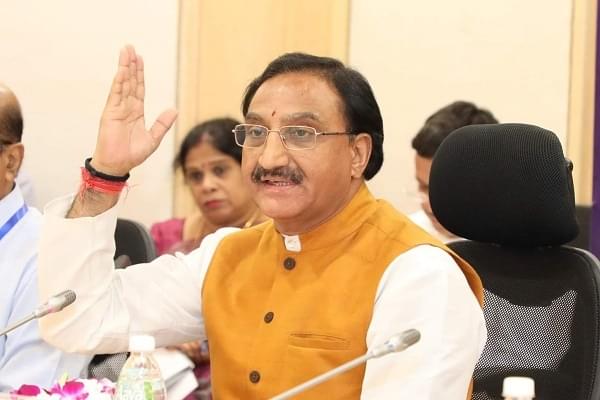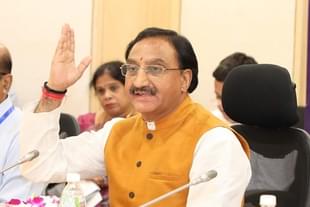Politics
NEP 2020: Modi Govt Has Missed A Historic Opportunity To Bring Real Change In India’s Failing Government School System
Arihant Pawariya
Jul 31, 2020, 07:05 PM | Updated 07:05 PM IST
Save & read from anywhere!
Bookmark stories for easy access on any device or the Swarajya app.


There is lot of excitement over the National Education Policy (NEP) released by the Narendra Modi government yesterday (30 July). It is divided into four parts: School education, higher education, other key focus areas such as professional education, technology, digital education, etc and finally how to implement the recommendations.
The first part on School Education has eight verticals:
1. Early Childhood Care and Education (ECCE);
2. Foundational literacy and numeracy;
3. Curtailing dropout rates and ensuring universal access to all levels;
4. Curriculum and pedagogy;
5. Teachers;
6. Equitable and inclusive education;
7. Effective governance and resourcing through school complexes/clusters;
8. Standard setting and accreditation.
All the NEP recommendations can be clubbed under four heads: proposals affecting a) government schools, b) private schools, and c) affecting both (like curriculum, standard setting/accreditation). Now, let’s discuss the proposals affecting government schools in detail and if they will bring any meaningful change. (Proposals affecting private schools and those affecting both will be discussed in next piece.)
The verticals dealing prominently with government schools are 1, 2, 3, 5, 6, and 7. Below, this piece will discuss NEP suggestions from these verticals.
Wrong diagnosis and non-solutions
It is no secret that India’s government schools are in a pitiful state. No wonder that between 2010 and 2017, over 2.5 crore students left the failing public school system and moved to private schools.
One expected NEP to strike at the root of the ills plaguing government schools and recommend bold reforms for a complete overhaul of the system. But NEP has failed in meeting this expectation.
Neither could it diagnose the problem with government schools well, nor could it suggest any concrete solutions which would help improve them.
NEP points out (mainly) four factors responsible for poor learning outcomes.
First, lack of early childhood care and education (ECCE). It notes that since ‘85 per cent of a child’s cumulative brain development occurs prior to the age of six’ - the age at which formal, compulsory schooling begins - lack of ECCE significantly impacts learning outcomes in primary school and beyond. The problem is more pronounced in students from disadvantaged backgrounds.
Second, the curriculum in initial grades fails in imparting foundational literacy and numeracy in kids which can make a his or her life in higher grades easier by giving him a solid foundation.
Third, the lack of teachers who are specially trained for ECCE apart from higher pupil-teacher ratio.
Fourth, poor health and lack of good quality nutrition and insufficient quantity, leading to poor learning outcomes.
Fifth, poor access and dropouts due to lack of infrastructure in schools and support systems.
There is no doubt that all these issues are serious ones and the reforms suggested by the NEP - to focus on ECCE and laying the foundation for basic numeracy and literacy from age 3 to 8 (up to Class 2); introducing ECCE-focused curriculum; hiring the best teachers, giving them good training, not allocating non-teaching chores to them, lowering Pupil Teacher ratio, providing them basic infrastructure for ease of working, and launching breakfast meals in schools apart from mid-day meals; providing most basic infrastructure facilities are all worthy suggestions which will help move the needle on government schools reform. But not by much.
If these were the real problems, then the difference between learning outcomes of private school children and government school children wouldn’t be as stark as it is today. According to the 2018 ASER report, 65 per cent Class V children in private schools in rural India could read a Class II level text, while only 44 per cent of children in government schools could do so - a difference of 21 percentage points. Ten years ago, this gap was 15 percentage points. During this period, enrollment of children in private schools went up from 18 per cent to over 30 per cent now.
Compared to private schools, the government schools have more qualified teachers, expenditure is many times more than private schools per pupil, basic infrastructure is better, free mid-day meal is available and a higher pupil teacher ratio, still the latter is far behind.
Still, the NEP’s suggestion is to throw more money on inefficient anganwadi system which will now be forced to turn into full time play schools or on other aspects where government schools already have a significant advantage over private schools, but still have failed to deliver.
A dangerous and divisive idea
Under the vertical “Equitable and inclusive education’, the draft NEP recommends a dangerous and divisive idea of carving out special education zones in the country based on identity (effectively on caste and religion) as it believes that areas where disadvantaged groups such as SCs, STs, OBCs, Muslims, et cetera are in present in significant numbers are also the areas which lack behind in education outcomes.
While the truth is that even in those areas where disadvantaged sections are not in majority, government schools have overwhelming number of students from these groups.
So, instead of focussing on certain areas, if the government can focus on reforming all the government schools in a non-discriminatory manner, it would do the greatest service to the disadvantaged sections of society - irrespective of whether they are living in majority or minority.
Missed opportunity
The failure of government schools in India is chiefly about the lack of incentives. Two things could bring drastic positive change: governance of these schools and teacher accountability. The NEP deals with both the issues.
First, it recommends school consolidation - at least administratively if not physically. This step is necessitated because as the data shows, we now have too many government schools with small number of students. If in an area, there are different schools catering to primary, secondary and higher levels, all of them will be consolidated into one school complex under one management with representatives from all individual schools who will also be independently governed by their own management committees.
This, NEP says, will end isolation of small schools, help in sharing various resources between them (infrastructure, teachers/staff, academic material, et cetera), and result in better management.
While all this is good, it doesn’t address the fundamental question of fixing accountability. The idea of empowering School Complex management committees (having parents of students as majority of members) is a big step in the right direction but these were mandated in RTE Act too and there is a reason why they have come a cropper even after 10 years of implementation of the legislation.
Second, on teachers, the NEP dedicates a whole section. It suggests linking teacher salary increases and promotions to merit and performance which will be determined by a combination of factors such as reviews by students, peers, attendance, et cetera. Additionally, their promotions and salary increases will be done only after endorsement of school management committee (which will have parents of students in majority).
While this is an improvement, it would have been great If the NEP made the learning outcomes of students of teachers a factor in their promotions and salary increases.
Nonetheless, this is a good development but one wonders how it will fit into our reservation system where we have quota not just in recruitment but in promotions as well. Surprisingly, the document is completely silent on this aspect.
On teacher education, the draft NEP misses a golden opportunity to show boldness and liberate it from the clutches of outdated model of B.Ed monopoly. In an era of teacher certification and platforms such as Unacademy, Coursera, Khan Academy, Byju’s, et cetera where good teachers (almost no B.Eds) are rewarded based on their teaching ability and student reviews, recommending a system where teachers are taught how to teach in a four-year integrated course or one/two-year course for lateral entry is a waste of time and resources.
Not only that, now B.Ed will be offered in multidisciplinary universities. Those aspiring to become teachers will not only have to learn education and their subject of specialisation but also subjects like history, sociology, psychology and other social science subjects. This NEP’s obsession with unnecessarily injecting arts into every sphere of education is really worrying.
As far as being eligible for teaching is concerned, a simple teacher eligibility test followed by a test for specialisation in a subject or two should suffice. Finally, there could be an interview stage where teaching abilities are tested via demonstration.
Chairperson of the NEP committee, Dr. K. Kasturirangan has earlier said that ‘we want to make teachers a cadre which is as serious, with credentials as any other cadre, such as a computer engineer, mechanical engineer.’
At a time when engineering itself as a professional course is becoming obsolete, dreaming of such “cadres” for teachers shows how far removed from reality our policymakers are. Nowadays, software firms don’t care if you have a computer science degree or not as long as you can code. It doesn’t matter whether you learnt it in a college, through an online course or even taught yourself.
The Modi government had a historic opportunity to recommend a bitter pill for the ailing government school system to revive. Sadly, it has disappointed. While positive affects of NEP 2020 on government school system will depend largely on how well the good suggestions are implemented, the bad ideas that are part of this policy have the potential to inflict serious harm in the long run.
Arihant Pawariya is Senior Editor, Swarajya.





